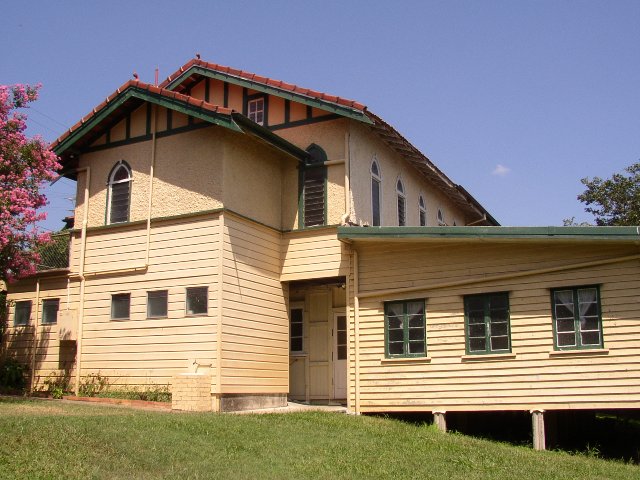Addresses
Type of place
Church
Period
Interwar 1919-1939
Style
Composite
Addresses
Type of place
Church
Period
Interwar 1919-1939
Style
Composite
The Morningside Seventh Day Adventist Church was built in 1929 as the expanding congregation prompted the need for one large, central church. The residential-style building features elements of both the Mediterranean and Old English styles of interwar architecture and includes additional rooms for a Sabbath school and recreation hall. A classroom was also added to the building in 1958.
Also known as
Iglesia Adventita Espana
Lot plan
L82_RP12840; L83_RP12840
Key dates
Local Heritage Place Since —
Date of Citation —
Construction
Roof: Terracotta tile;Walls: Timber
Criterion for listing
(A) Historical; (D) Representative; (G) SocialInteractive mapping
Also known as
Iglesia Adventita Espana
Lot plan
L82_RP12840; L83_RP12840
Key dates
Local Heritage Place Since —
Date of Citation —
Construction
Roof: Terracotta tile;Walls: Timber
Criterion for listing
(A) Historical; (D) Representative; (G) SocialInteractive mapping
History
The land on which this church stands was purchased by the Australasian Conference Association (the Seventh Day Adventist Church) mid 1929. It had been part of a large parcel of land owned by Joseph Walter Tritton of the famous Brisbane furniture manufacturing family. This sizeable allotment stretched from Lawson Street and New Cleveland Road (now Wynnum Road) to the north and south, and Thynne Road and Riding Road to the east and west.
Early Adventist worship in the area had been conducted in a variety of localities, but a growing congregation prompted the construction of a dedicated church. Up to this time the population of Morningside had steadily increased, as it had in the surrounding suburbs. A late nineteenth century upsurge in residential development was followed by another in the interwar years. This last growth period had been preceded by significant subdivision of large parcels of land. A deal of this subdivision took place during or immediately after the First World War. Indeed, Tritton's allotment was mostly subdivided between 1913 and 1918.
In 1929 two lots totalling 32 perches were acquired and the church building was erected soon afterwards. The builder was J.W. Groom and the configuration of the block, which is considerably below road level, was exploited to provide a church above two smaller rooms. These served as a sabbath school and recreation hall respectively.
The building provided space for junior and senior branches of the Missionary Volunteer Society as well as the Dorcas society, which provided assistance to needy people. Early worshippers at the church included the President of the Queensland Conference, Pastor W.G. Turner and Mrs John Tritton. In recent years the church appears to have specialised in serving the Spanish Adventist community, though no records are presently available to determine exactly when this policy was adopted.
Examination of historical plans and aerial photographs show that the building largely retains its early configuration, though Council records show that a classroom was added to the building in 1958. This appears to be the same structure that presently exists at the rear of the church. The Church itself has a terracotta tiled gable roof with a projecting front porch and end bay. Walls are pebble-dash render to the upper part, with weather boards below. Windows are Gothic-arched with leadlight fanlights above louvres. Floors are timber on low concrete stumps. Access from the road to the upper level was originally by a bridge to the central projecting porch. This porch was originally open, but has since been enclosed, and the bridge access moved to one side.
The building is significant as a place of worship and community service that was purpose built by the Seventh Day Adventist Church and then used by them for nearly seventy-five years. This lengthy usage also makes it significant in the history of religious worship in Morningside in the 20th century. The building has also made a constant and significant contribution to this part of the local streetscape since its erection in 1929.
Statement of significance
Relevant assessment criteria
This is a place of local heritage significance and meets one or more of the local heritage criteria under the Heritage planning scheme policy of the Brisbane City Plan 2014. It is significant because:
Citation prepared by — Brisbane City Council (page revised June 2022)

